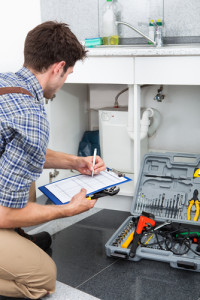 Maintaining a home in San Diego differs a bit from other areas of the country–particularly in our coastal region. We don’t have blankets of snow in the winter and we tend to be surprised when rain storms arrive. Our gardens grow year round and we fear termites more than thunderstorms.
Maintaining a home in San Diego differs a bit from other areas of the country–particularly in our coastal region. We don’t have blankets of snow in the winter and we tend to be surprised when rain storms arrive. Our gardens grow year round and we fear termites more than thunderstorms.
So what are some things you can do to avoid costly repairs in the future?
Here are some items to keep in mind, especially if you got a “great deal” on your home because it needed a little TLC.
Little Drips and Leaks
Plumbing maintenance can break the bank if you ignore those little drips, clogs or strange sounds in the pipes. Leaks and drips under the sink are out of sight, so they often are out of mind. However, a buildup of moisture in a sink cabinet can set the stage for costly mold problems.
If the leak is on an upper level and the moisture seeps into the walls and subfloor, it can endanger the structural integrity of the ceiling below. Latex paint has the particular ability to “stretch” and hold moisture. When this happens, you may not notice the damage to the ceiling below until the paint forms a moisture-filled bubble. By this point, drywall, insulation and subfloor will need extensive and expensive repairs.
Better to get the leak looked at right away by a certified plumber.
Roofing
An untrained eye may judge a roof to be perfectly fine, but hail, unexpected downpours or wind can damage to your roof and the walls/ceilings below. Lefteft unrepaired, a damaged roof exposes your home to the elements, inviting potential damage and mold. Here are some signs you need an expert roofer to inspect your home:
- Missing shingles:Heavy downpours and strong windstorms can tear shingles away. While roofing tiles are designed to overlap, offering double protection, when one layer is missing, water can seep underneath and cause damage. Having a few shingles replaced is much less expensive than have to completely replace the deck (the layer of wood under your roof) of your home and completely re-roof it.
- Curling or lifting shingles: A curled shingle or a row of lifted or buckled shingles indicates that you may already have a leak, or the potential for one. Have these shingles replaced immediately and inspect the deck and sub-roof materials for damage.
- Decay and mold: When mold, moss or lichen grows on your roof it’s a sign that areas of the roof are holding water. Treat the growths with a killing agent immediately. Have damaged shingles repaired as soon as possible.
- Damaged flashing and drip edge: Flashing refers to the metal or vinyl pieces that surround chimneys, pipes, exhaust fans, while a drip edge is the metal piece along the outer edge of the roof. If any of the metal or vinyl pieces are bent, buckled, dented or have holes, your home may be exposed to water damage. A certified roofer can repair flashing and drip edges.
- Gutters are the metal or vinyl troughs that collect water runoff and direct it to downspouts away from the home. Gutters require extra maintenance. In the fall, leaves and debris collect in gutters potentially damning them and causing water to back up under the roofing tiles. Make sure to clean gutters each year before winter weather begins.
It’s also important to have sufficient insulation in your attic to avoid overheating your roof, and sufficient ventilation where accumulated heat can escape.Electrical Problems
If you have a breaker that continually trips or (in older homes) a fuse that blows, you may have an electrical problem. Of course, you may simply have too many items running on one breaker, but blown fuses and continually tripping breakers may indicate a fire hazard.
Have your home inspected by a certified electrician. If you own an older home, with fuses, consider having them replaced with modern breakers. Replace outlets in bath areas with a GFI (ground fault interrupter) outlet that switches off when the outlet is overloaded or when the appliance comes in contact with water.
We want your home ownership to be the best possible experience. We additionally suggest getting an inspection before purchasing your home, and a yearly or bi-annual maintenance inspection to keep your home in top shape. When the time comes to sell this home and move to another one, you won’t have costly repairs needed before you can put it on the market–and you’ll make living in your San Diego home a more joyful experience–and one not plagued by fear of costly repairs.
- If you have any questions about home maintenance or need referrals for local contractors, please give us a call at either 877-818-8197 or 760-402-9101. Or simply email murphygroup@gmail.com. (And if you have recommendations for an excellent contractor, please let us know!)
